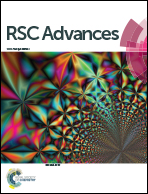An enzyme-mediated in situ hydrogel based on polyaspartamide derivatives for localized drug delivery and 3D scaffolds†
Abstract
An injectable and biodegradable enzymatically crosslinked hydrogel based on poly(α,β-aspartic acid) modified with tyramine (TA) and 3-amino-1-propanol (AP) (PASP-g-TA/AP) was prepared under physiological conditions in the presence of horseradish peroxidase (HRP) and hydrogen peroxide (H2O2). The polymer PASP-g-TA/AP was readily synthesized through aminolysis of polysuccinimide (PSI) with TA and subsequently with AP. The gelation time could be tuned from 10 s to 8 min by modulating the concentrations of polymer, HRP and H2O2 cooperatively. Studies on swelling ratio, hydrogel morphology and a rheology analysis further demonstrated the relationship between the crosslinking density and the concentrations of the polymer, HRP and H2O2. The PASP-g-TA/AP hydrogels displayed a considerable capacity to control the release of hydrophilic small model drugs at higher polymer concentrations. The cell culture study showed that COS-7 cells exhibited high viability in vitro and notable proliferation when cultured within the PASP-g-TA/AP hydrogel. After subcutaneous injection into mice, the PASP-g-TA/AP hydrogels formed rapidly in situ and persisted for up to 30 days with an acceptable inflammatory response. These results suggest that the newly described PASP-g-TA/AP hydrogels have good biocompatibility and are promising biomaterials as targeted drug delivery carriers and three-dimensional scaffolds.



 Please wait while we load your content...
Please wait while we load your content...